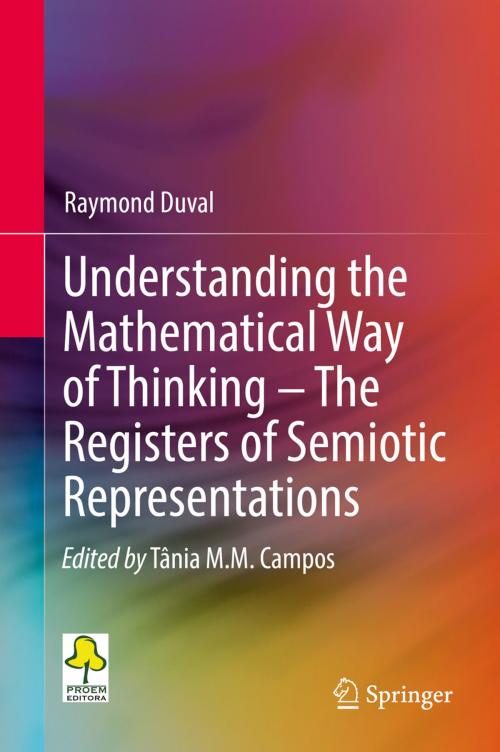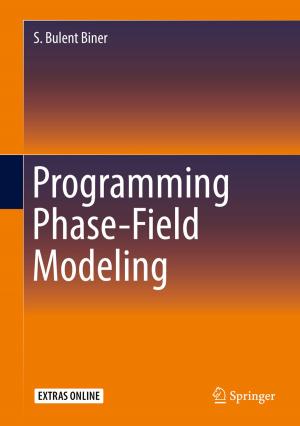Understanding the Mathematical Way of Thinking – The Registers of Semiotic Representations
Nonfiction, Reference & Language, Education & Teaching, Educational Theory, Educational Psychology, Teaching, Teaching Methods| Author: | Raymond Duval | ISBN: | 9783319569109 |
| Publisher: | Springer International Publishing | Publication: | July 18, 2017 |
| Imprint: | Springer | Language: | English |
| Author: | Raymond Duval |
| ISBN: | 9783319569109 |
| Publisher: | Springer International Publishing |
| Publication: | July 18, 2017 |
| Imprint: | Springer |
| Language: | English |
In this book, Raymond Duval shows how his theory of registers of semiotic representation can be used as a tool to analyze the cognitive processes through which students develop mathematical thinking. To Duval, the analysis of mathematical knowledge is in its essence the analysis of the cognitive synergy between different kinds of semiotic representation registers, because the mathematical way of thinking and working is based on transformations of semiotic representations into others. Based on this assumption, he proposes the use of semiotics to identify and develop the specific cognitive processes required to the acquisition of mathematical knowledge. In this volume he presents a method to do so, addressing the following questions:
• How to situate the registers of representation regarding the other semiotic “theories”
• Why use a semio-cognitive analysis of the mathematical activity to teach mathematics
• How to distinguish the different types of registers
• How to organize learning tasks and activities which take into account the registers of representation
• How to make an analysis of the students’ production in terms of registers
Building upon the contributions he first presented in his classic book Sémiosis et pensée humaine, in this volume Duval focuses less on theoretical issues and more on how his theory can be used both as a tool for analysis and a working method to help mathematics teachers apply semiotics to their everyday work. He also dedicates a complete chapter to show how his theory can be applied as a new strategy to teach geometry.
“Understanding the Mathematical Way of Thinking – The Registers of Semiotic Representations is an essential work for mathematics educators and mathematics teachers who look for an introduction to Raymond Duval’s cognitive theory of semiotic registers of representation, making it possible for them to see and teach mathematics with fresh eyes.”
Professor Tânia M. M. Campos, PHD.
In this book, Raymond Duval shows how his theory of registers of semiotic representation can be used as a tool to analyze the cognitive processes through which students develop mathematical thinking. To Duval, the analysis of mathematical knowledge is in its essence the analysis of the cognitive synergy between different kinds of semiotic representation registers, because the mathematical way of thinking and working is based on transformations of semiotic representations into others. Based on this assumption, he proposes the use of semiotics to identify and develop the specific cognitive processes required to the acquisition of mathematical knowledge. In this volume he presents a method to do so, addressing the following questions:
• How to situate the registers of representation regarding the other semiotic “theories”
• Why use a semio-cognitive analysis of the mathematical activity to teach mathematics
• How to distinguish the different types of registers
• How to organize learning tasks and activities which take into account the registers of representation
• How to make an analysis of the students’ production in terms of registers
Building upon the contributions he first presented in his classic book Sémiosis et pensée humaine, in this volume Duval focuses less on theoretical issues and more on how his theory can be used both as a tool for analysis and a working method to help mathematics teachers apply semiotics to their everyday work. He also dedicates a complete chapter to show how his theory can be applied as a new strategy to teach geometry.
“Understanding the Mathematical Way of Thinking – The Registers of Semiotic Representations is an essential work for mathematics educators and mathematics teachers who look for an introduction to Raymond Duval’s cognitive theory of semiotic registers of representation, making it possible for them to see and teach mathematics with fresh eyes.”
Professor Tânia M. M. Campos, PHD.















